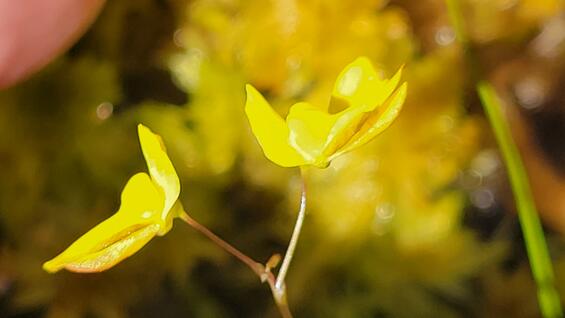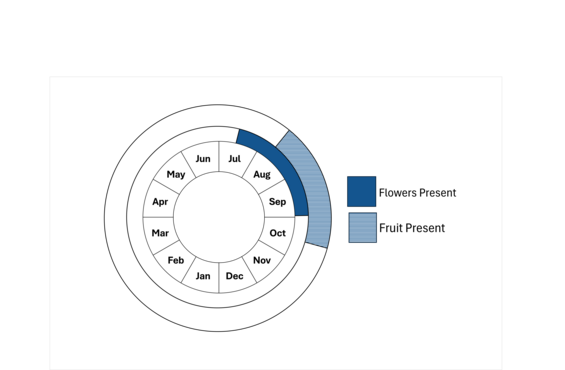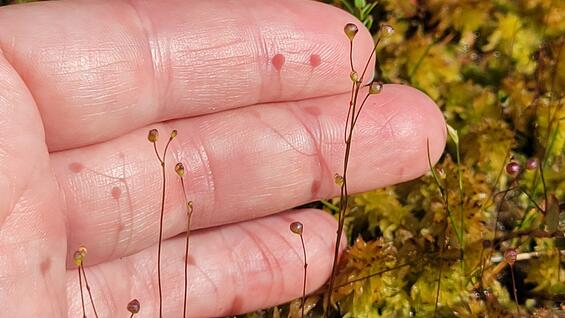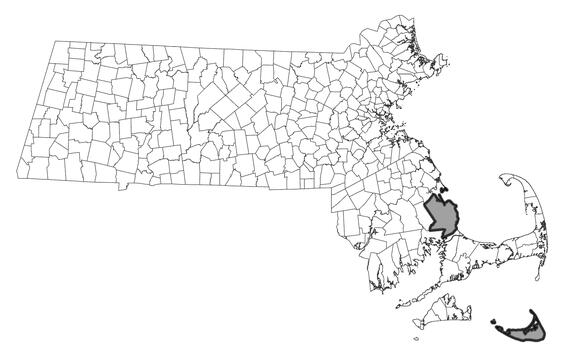- Scientific name: Utricularia subulata L.
- Species of Greatest Conservation Need (MA State Wildlife Action Plan)
- Threatened (MA Endangered Species Act)
Description

Side view of flower with appressed spur. Photograph by Kelly Omand, Nantucket Conservation Foundation.
Slender bladderwort, Utricularia subulata, is a tiny semi-aquatic annual plant in the bladderwort family (Lentibulariaceae). Slender bladderwort is composed of a subterranean system of delicate, unbranched, bladder-bearing stems (traps for invertebrates) from which thread-like, leafless flower scapes emerge 4-18 cm (1.5-6 in) above the substrate. Small, uncut, leaf-like branchlets may also be present, borne on the underground stems. Its flowers have a bilabiate (two-lipped) corolla, the upper lip smaller and rounded, the lower one large, broad and shallowly 3-lobed with a short spur pressed beneath it. More often, however, the flowers lack any well-developed petals and look simply like fruiting capsules. These cleistogamous (hidden) flowers are self-fertilized without the flower ever expanding. A colony of them looks like tiny hatpins stuck in the sand or mud.
Slender bladderwort is similar to two other yellow-flowered bladderworts, horned bladderwort (U. cornuta) and the humped bladderwort (U. gibba). Horned bladderwort has a downward directed spur, while slender bladderwort has the short corolla spur appressed to the lower lip. Humped bladderwort has floating or creeping branches with many finely dissected leaves and scattered bladders, separately or together, while slender bladderwort has only underground bladders and few, if any, simple (undivided) leaves. Slender bladderwort is usually found stranded away from current water levels, whereas the humped bladderwort is usually emergent at the water's edge.
Life cycle and behavior
Slender bladderwort is an annual (occasionally perennial) species unlike most other bladderworts in Massachusetts, as it only has its stems with bladders in the substrate rather than floating near the surface of the water. In mid-July to late September, flowering stalks will appear with two to four tiny yellow flowers per stalk (which are insect pollinated). These appear once water has retreated and created an open shoreline at the ponds edge. A single peltate bract (attached in the middle of the bract) is at the base of the flower stalk. Slender bladderwort prolifically produces tiny self-pollinating flowers that do not open. Plants spread both by seeds and vegetatively in the substrate.

Population status

Seed heads and cleistogamous flowers. Photograph by Kelly Omand, Nantucket Conservation Foundation.
Slender bladderwort is listed under the Massachusetts Endangered Species Act as threatened. All listed species are protected from killing, collecting, possessing, or sale, and from activities that would destroy habitat and thus directly or indirectly cause mortality or disrupt critical behaviors. There are currently nine populations of slender bladderwort in the state that have been verified since 1999. These occur in Barnstable, Dukes, Nantucket and Plymouth Counties.
Extensive populations of slender bladderwort occur at several Massachusetts sites and are currently protected at nine coastal plain ponds. Historically (prior to 1990), it was more prevalent and has been documented from 24 sites in the state. However, through recent development and recreational use of many of the region’s coastal ponds, this species' habitat has significantly decreased. The pantropic temperature range this species requires rarely seems to occur in MA.
Distribution and abundance
Southeastern Massachusetts and southern Nova Scotia represent the northern limit of this species’ range which extends south along the coastal states to Florida, westward to Texas, inland to Missouri, Nebraska and Illinois, extending north to southern Michigan. It is also found throughout South America, tropical Africa, Madagascar, Thailand, and Borneo. It is considered rare through much of its northern range. In New England, it is only known from Rhode Island (critically imperiled) and Massachusetts (imperiled). It is extirpated in Pennsylvania and Oklahoma, and imperiled or critically imperiled in Arkansas, Illinois, Indiana, Michigan, Missouri, Nebraska, New York, Tennessee, and West Virginia.

Habitat
This species primarily grows in wet, sandy to peaty soils on the margins of shallow coastal plain freshwater ponds which undergo pronounced seasonal fluctuations in water level. These permanent bodies of water were created from buried blocks of glacial ice and are found scattered throughout the glacial outwash which was deposited over much of southeastern Massachusetts. A rich community of specially adapted species, many rare and threatened, is able to thrive because the encroachment of trees and shrubs is prevented by the recurring high-water levels in these ponds. Slender bladderwort is also found in boggy depressions and on peaty scrapes where saturated and sunny conditions are also conducive to the growth of certain low, herbaceous species. Commonly found growing with slender bladderwort are thread-leaved sundew (Drosera filiformis), yellow-eyed grass (Xyris difformis), bog buttons (Eriocaulon aquaticum), white beak-sedge (Rhynchospora alba), and redroot (Lachnanthes caroliana), another listed plant species which happens to reach its northern range limit at the same location as slender bladderwort.
Healthy habitats are vital for supporting native wildlife and plants. Explore habitats and learn about conservation and restoration in Massachusetts.
Threats
The primary threat to this species is degradation of its habitat and habitat loss. In greenhouse settings, it is considered prolific, even described as ‘weedy,’ (Kurosawa pers. obs.) but that is not what is observed in the natural settings in Massachusetts, and it may be struggling due to the cold climate conditions found here as it is a pan-tropical species. Recreational activities on coastal plain pond shores may destroy plants accidentally through trampling, boat launching, etc. Increase in precipitation as predicted by climate change models (Staudinger et al. 2024) may make open shoreline habitat less frequent as water levels remain higher, making it more difficult for this species to flower and produce seed.
Conservation
Regular surveys are absolutely needed for this species. It may start flowering in July and finish early or start later. Surveyors should plan to visit populations multiple times during the growing season and know that if the water levels do not drop and the shoreline is not exposed, these diminutive plants will not produce flowering stems. When observing plants in flower, each stem should be considered a ramet. The best time to survey for slender bladderwort is mid-July through August.
Protection of the coastal plain pond shorelines where this species occurs is the most important management action. The ecology of this species in Massachusetts is not fully understood, but prevention of trampling is critical. Shoreline invasive species, such as common reed (Phragmites australis) is also a threat to this species. All active management of rare plant populations (including invasive species removal) is subject to review under the Massachusetts Endangered Species Act and should be planned in close consultation with the MassWildlife’s Natural Heritage & Endangered Species Program.
It is not fully understood why this species is not as prolific as expected, nor why it does not occur with other bladderworts. Experiments could be conducted growing slender bladderwort at different temperature regimes, and under different water levels to determine its tolerance ranges. It would be helpful to know if seed produced from plants in Massachusetts has a wider temperature tolerance than those available from southern state populations where it is more common.
References
Crow, Garrett E. and C. Barre Hellquist. Aquatic and Wetland Plants of Northeastern North America, Volume 1. University of Wisconsin Press, Madison, Wisconsin, 2000.
Haines, A. 2011. Flora Novae Angliae – a Manual for the Identification of Native and Naturalized Higher Vascular Plants of New England. New England Wildflower Society, Yale Univ. Press, New Haven, CT.
Kurosawa, Emmi. 2023. Species Listing Proposal Form for Utricularia subulata.
Native Plant Trust. 2014. NORM Phenology Information.
NatureServe. 2025. NatureServe Network Biodiversity Location Data accessed through NatureServe Explorer [web application]. NatureServe, Arlington, Virginia. Available https://explorer.natureserve.org/. Accessed: 3/4/2025.
POWO (2025). "Plants of the World Online. Facilitated by the Royal Botanic Gardens, Kew. Published on the Internet; https://powo.science.kew.org/ Retrieved 06 January 2025."
Staudinger, M.D., A.V. Karmalkar, K. Terwilliger, K. Burgio, A. Lubeck, H. Higgins, T. Rice, T.L. Morelli, A. D'Amato. 2024. A regional synthesis of climate data to inform the 2025 State Wildlife Action Plans in the Northeast U.S. DOI Northeast Climate Adaptation Science Center Cooperator Report. 406 p. https://doi.org/10.21429/t352-9q86
Contact
| Date published: | May 7, 2025 |
|---|